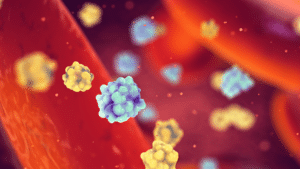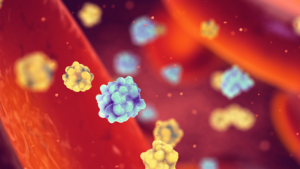
Cannabinoid receptors CB1 and CB2 are the definitive and best-known targets of endogenous and plant-derived cannabinoids, but they’re far from the only ones.
Several phytocannabinoids, including cannabidiol (CBD), for example, and the two primary endocannabinoids — anandamide and 2-AG — have been shown to interact with peroxisome proliferator-activated receptors, or PPARs1 (pronounced pee-parrs), which are found on the surface of the cell’s nucleus. This may help to explain how CBD, which has little affinity for either CB1 or CB2, can do so much.
Get to Know the PPARs
PPARs are a group of nuclear receptors that play important roles in regulating metabolism, inflammation, and gene expression. Triggered by hormones, endocannabinoids and other fatty acid derivatives, and various nutritional compounds,2 PPARs are expressed in different parts of the body:
- PPAR-a (PPAR-alpha) is found in the liver, kidney, heart, and skeletal muscle, as well as adipose (fat) tissue and the intestinal tract;
- PPAR-b (PPAR-delta) is expressed in adipose tissue, skeletal muscle, heart, and liver; and
- PPAR-y (PPAR-gamma), which comes in two forms, is expressed in almost all tissues of the body including the colon, the cardiovascular system, and immune cells.
The first evidence of an endocannabinoid interacting with PPARs came in 2002, when a research team in Tennessee showed that a metabolite of 2-AG activated PPAR-a.3 Since then many more breakthroughs have been made, and peroxisome proliferator-activated receptors are now viewed as an extension of the classic endocannabinoid system (ECS).
Two recent papers reiterate the point that to really understand cannabinoids (especially CBD) and the ECS, it’s essential to get to know the PPARs.
CBD, Psychosis & Glucose Metabolism
A March 2023 study in the journal Frontiers in Psychiatry4 suggests that CBD may act through a PPAR receptor to enhance cerebral glucose metabolism, alterations of which are associated with a host of metabolic and cognitive disorders.5
The paper describes the case of a 19-year-old man in Germany who presented at the Cologne Early Recognition and Intervention Center with “a marked cognitive decline within [six] months, anhedonia, ambivalence, social withdrawal, poverty of speech, and brief, limited intermittent psychotic symptoms, particularly delusions and hallucinations.”
Prior to this, the man had no psychiatric history, the authors note. He had never taken anti-psychotic drugs nor received psychological treatment. And besides an uncle with bipolar disorder, he had no family history of other psychiatric or neurological diseases.
The man’s doctors — two of the paper’s four authors — knew that over the last decade-plus, CBD has begun to be recognized through animal and human studies as a novel therapeutic compound for psychosis that acts via indirect effects on the ECS.6,7 They wanted to try it.
“Due to its excellent tolerability and promising efficacy … and its innovative new mechanisms of action, we decided to offer a respective treatment with cannabidiol to [the] patient,” they write.
The prescription was 600 mg of pure CBD orally per day for 30 days. And it worked. The authors report a substantial clinical improvement in attention, visual processing, visuomotor speed, working memory, and other parameters beginning by day seven, with no adverse events or side effects. That’s quite notable in and of itself — but it’s their investigation of potential mechanisms of action that really contributes to the conversation.
Mechanisms of Action
Using brain scans and blood draws, the researchers observed that this reduction in clinical symptoms was accompanied by enhancement of cerebral glucose utilization — a critical metabolic process whose impairment is implicated in Alzheimer’s Disease, schizophrenia, diabetes, obesity, and more.8
They suggest that the underlying mechanism linking CBD intake, cerebral glucose utilization, and improved psychiatric symptoms may be none other than PPAR-y, one of the three known PPAR receptors. PPAR-y plays an essential role in regulating glucose homeostasis and neuroinflammation, and is directly activated by both CBD and the endocannabinoid anandamide (AEA). (AEA’s molecular fatty-acid cousins, PEA and OEA, activate PPAR-a.)
The proposed link between CBD, cerebral glucose metabolism, psychiatric symptoms, and PPAR-y makes sense, even if it has yet to be proven definitively. Previous research has linked CBD’s efficacy in treating psychosis to its ability to boost AEA,9 which binds with PPAR-y. PPARs in general are recognized as a potential target for treating psychiatric disorders.10 And a 2022 study showed that CBD treatment improved both glucose metabolism and memory in a rat model of Alzheimer’s Disease.11
“The direct or indirect activation of PPAR-γ by cannabidiol may represent one of the various possible mechanisms relevant to the promising antipsychotic effects of cannabidiol,” the authors conclude. Yes, more research is needed — but what matters most to the patient is that it helps.
Cannabidiol Goes Nuclear
A review article in the journal Phytomedicine12 also published in March 2023 provides a broader look at the clinical implications of CBD’s affinity for PPAR-y. Appearing under the catchy title “Cannabidiol goes nuclear: The role of PPARy,” the paper summarizes existing research into the many ways in which interactions between the two influence human health.
Based on an examination of 78 previous articles, the Iran-based authors determined that CBD’s effects on a long list of conditions (Alzheimer’s disease and memory loss, Parkinson’s disease and movement disorders, multiple sclerosis, anxiety and depression, cardiovascular disease, immune conditions, cancer, and obesity) are mediated at least in part by PPAR-y.
The ubiquitous receptor manages this not only through glucose homeostasis, the authors write, but also by changing the expression of various genes implicated in insulin release, lipid metabolism, inflammation, and immunity. And they note that many effects of CBD can be prevented by synthetic PPAR-y antagonists, which are utilized as research tools.
Ultimately, the review underscores that PPAR-y is a key target for CBD — and argues quite convincingly that “[the receptor’s] activation by CBD should be considered in all future studies.”
Nate Seltenrich, Project CBD contributing writer, is the author of the column Bridging the Gap. He is an independent science journalist based in the San Francisco Bay Area, covering a wide range of subjects, including environmental health, neuroscience, and pharmacology. © Copyright, Project CBD. May not be reprinted without permission.
Footnotes
- O’Sullivan, Saoirse Elizabeth. “An update on PPAR activation by cannabinoids.” British journal of pharmacology vol. 173,12 (2016): 1899-910. doi:10.1111/bph.13497
- Scandiffio, Rosaria et al. “Beta-Caryophyllene Modifies Intracellular Lipid Composition in a Cell Model of Hepatic Steatosis by Acting through CB2 and PPAR Receptors.” International journal of molecular sciences vol. 24,7 6060. 23 Mar. 2023, doi:10.3390/ijms24076060
- Karkhanis, Anil et al. “15-Lipoxygenase Metabolism of 2-Arachidonylglycerol: Generation of a Peroxisome Proliferator-Activated Receptor α Agonist.” Journal of medicinal chemistry vol. 57,11 (2014): 4830-4840.
- Koethe, Dagmar et al. “Cannabidiol enhances cerebral glucose utilization and ameliorates psychopathology and cognition: A case report in a clinically high-risk mental state.” Frontiers in psychiatry vol. 14 1088459. 3 Mar. 2023, doi:10.3389/fpsyt.2023.1088459
- Rebelos, Eleni et al. “Brain Glucose Metabolism in Health, Obesity, and Cognitive Decline-Does Insulin Have Anything to Do with It? A Narrative Review.” Journal of clinical medicine vol. 10,7 1532. 6 Apr. 2021, doi:10.3390/jcm10071532
- Rohleder, Cathrin et al. “Cannabidiol as a Potential New Type of an Antipsychotic. A Critical Review of the Evidence.” Frontiers in pharmacology vol. 7 422. 8 Nov. 2016, doi:10.3389/fphar.2016.00422
- Davies, Cathy, and Sagnik Bhattacharyya. “Cannabidiol as a potential treatment for psychosis.” Therapeutic advances in psychopharmacology vol. 9 2045125319881916. 8 Nov. 2019, doi:10.1177/2045125319881916
- Rebelos, Eleni et al. “Brain Glucose Metabolism in Health, Obesity, and Cognitive Decline-Does Insulin Have Anything to Do with It? A Narrative Review.” Journal of clinical medicine vol. 10,7 1532. 6 Apr. 2021, doi:10.3390/jcm10071532
- Davies, Cathy, and Sagnik Bhattacharyya. “Cannabidiol as a potential treatment for psychosis.” Therapeutic advances in psychopharmacology vol. 9 2045125319881916. 8 Nov. 2019, doi:10.1177/2045125319881916
- Matrisciano, Francesco, and Graziano Pinna. “The Strategy of Targeting Peroxisome Proliferator-Activated Receptor (PPAR) in the Treatment of Neuropsychiatric Disorders.” Advances in experimental medicine and biology vol. 1411 (2023): 513-535. doi:10.1007/978-981-19-7376-5_22
- de Paula Faria, Daniele et al. “Cannabidiol Treatment Improves Glucose Metabolism and Memory in Streptozotocin-Induced Alzheimer’s Disease Rat Model: A Proof-of-Concept Study.” International journal of molecular sciences vol. 23,3 1076. 19 Jan. 2022, doi:10.3390/ijms23031076
- Khosropoor, Sara et al. “Cannabidiol goes nuclear: The role of PPARγ.” Phytomedicine: international journal of phytotherapy and phytopharmacology vol. 114 (2023): 154771. doi:10.1016/j.phymed.2023.154771
The post CBD Enhances Glucose Metabolism via Nuclear Receptors appeared first on Project CBD.

